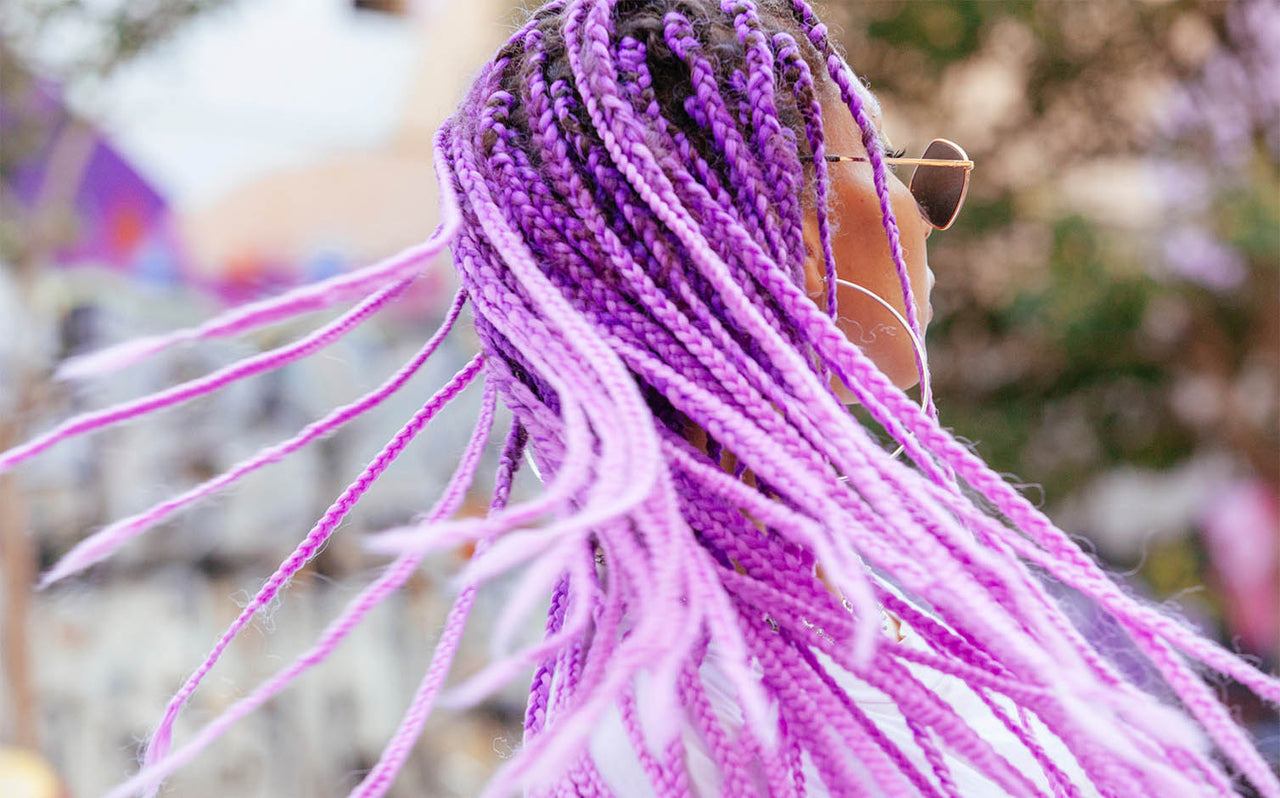Extensions and hair weaves and wigs - oh my! Thanks to amazing innovations in hair care technology there are now so many options for achieving your dream style (and changing it up) faster than ever.

Not only do wigs and extensions help you make a dramatic change in a matter of hours, but they also unlock a world of possibilities for people with damaged hair, or even hair loss. But whilst these techniques can give your vibe and confidence a boost, they all come with their pros and cons, so it’s important to do your research and find the right route for you.
Want to spend less time searching for answers and more time planning your next hair makeover? We get it. Which is why we asked Afro-textured hair specialist and celebrity stylist, The Snob, to round up her top tips on all things wigs, weaves and extensions, right here.
Synthetic Hair vs Virgin Hair
Let’s start with the basics. When it comes to weaves, extensions or wigs they are all made of real hair - sometimes called Virgin Hair - or fake hair aka synthetic hair.
Real hair is exactly what it sounds like - real human hair collected from donors. When people talk about Virgin Hair, they are referring to human hair that hasn’t been enhanced in any way - so no dyes and no chemical straightening. Some people prefer Virgin Hair and believe it is the best quality but this is generally a personal choice!
The benefits of using human hair are that it tends to last longer (saving you time and money in the salon) and can be treated as your own hair, for that seriously natural look. However, just like our own hair, washing will ruin any style you attempt, meaning you’ll have to spend more time finessing your looks come wash day.
Synthetic hair - synthetic fibres made out of acrylic or nylon - on the other hand, is much better at holding style, even after a wash. Whilst this might sound great, synthetic hair has its own issues when it comes to styling. Because of the materials it’s made with, it cannot withstand heat and will melt if attempted.
If you are going to go for wigs, weaves or extensions, you’ll need to think about what kind of hair you want to go for and how it will fit into your lifestyle and hairstyle!
What are hair extensions?
Simply put, hair extensions do exactly that - extend your natural hair. They can be created with either human or synthetic hair and can come in a variety of colours, lengths and styles. If you have always dreamed of having a mane of luscious long locks, but have struggled to get your growth on naturally, hair extensions could be the answer to your long hair prayers.
Different types of hair extensions
There are many different types of hair extensions - and different ways of attaching them. The right option for you will depend on a few factors - from your desired look and how long you want to keep them in for, to your budget and the condition of your natural hair. Once you have your hair extensions put in it's important you know how to care for your hair extensions.
● Tape in hair extensions - Extensions that come with a one inch strip of medical grade adhesive that is installed in a way that your natural hair goes between them. They are regarded as semi-permanent extensions and tend to last about 4-8 weeks.
● Micro ring hair extensions - Safe, secure and super comfortable, micro ring - sometimes called micro loop or micro bonded - come with tiny copper rings to combine strands of natural hair with the hair extensions. They can last up to 4 months!
● Weaving hair extensions - This technique involves sewing wefts of hair onto a braid of your natural hair - but more on that later... or you can find out more about weaved in hair extensions here.
● Clip in hair extensions - Clip ins are a temporary method of extension, perfect for adding length to your hair for a special occasion and easily removed afterwards. They are also one of the most affordable forms of hair extension.
● Hot fusion hair extensions - This method involves attaching individual strands of hair extension to your natural hair with keratin based tips. Because your hair is mainly made up of keratin, it doesn’t damage your natural style too much. With proper care, hot fusion hair extensions can last 3-6 months, depending on how fast your hair grows.
● Cold fusion hair extensions - Whilst hot fusion is generally safe for hair, this latest technology uses keratin based glue that can be attached to the natural hair without having to use heat to activate it - reducing damage even further. They are also pretty long lasting and you can generally wear them up to 4 months without needing another salon appointment.
What are the advantages of hair extensions?
There are a whole bunch of benefits to getting hair extensions, here are just a few...
● Instant hair change - Want to mix up your style? With extensions, you can go from a blunt bob to a long wavy mane in one salon trip!
● Low maintenance - Whilst your hair extensions require love and attention, once they are applied, they are pretty low maintenance
● Different appearances for different occasions - Want more volume for your wedding? You’ve got it. Waist length locks for your holiday, no problem!
● Can hide split ends - A good set of extensions can hide a multitude of sins (and split ends) and make your hair look healthier than ever!
● Can add colour - Whilst many people like to match their extensions to their natural colour, they also offer the opportunity to experiment with a bold new colourway.
● Provide more hair volume - It’s not just length that extensions can help with, they are also great for turning your hair volume up to max.
● Can experiment with hair styles - Not sure if you want to commit to growing your hair out? Extensions let you find out if that look is for you, before taking the plunge. Find out more about styling hair extensions.
● Affordable - Whilst the cost of extensions does vary, some options, like clip ins, are kind to your hair - and your bank balance.
What are the disadvantages of hair extensions?
So, it’s pretty clear we’re loving extension life. But there are a few potential downsides it’s important to be aware of...
● Glue used in hair extensions can damage hair - Whenever we use chemicals on our hair, there is always a risk of damage - and hair extension glue is no different.
● Can damage your hair if not removed properly - It’s not just the glue that can damage your natural hair - removing your extensions can also be a hair health minefield - and it’s always best to get it done professionally.
● They’re not reusable, which makes them expensive - If you’re thinking about getting extensions regularly, remember to think about the cost of the hair as well as application.
● Can cause discomfort through itchiness, headaches and irritation - A good hair extension should generally be pretty comfortable, but sometimes a little irritation is unavoidable.
● Can be noticeable - We’re always aiming for the most natural extension possible, but when done badly, it can be pretty obvious. Choose your hair and your hair stylist carefully.
● Can take a long time to put in - Whilst getting extensions is always going to be faster than waiting for your hair to grow, depending on the technique, it can still require a lengthy spell in the stylist’s chair
What is weave hair
So, here’s something to get your head around - all weaves involve hair extensions, but not all extensions involve a weave. A weave method of attaching hair extensions, usually used by people with thick or textured natural hair. For this technique the natural hair is braided and wefted hair extensions are sewn into the braids with a needle and thread. Much like hair extensions, weave hair allows you to experiment with styles and add length to your hair pretty quickly - it’s also a good way to protect your natural hair whilst growing it out.
What are the different types of weaves?
Just like hair extensions, there are a few different ways to attach a weave.
● Full Sew-In - Full sew-in is when all of your hair is braided and none of your natural hair is left out to cover the tracks of the sew-in.
● Partial Sew-In - A partial sew-in is when half of your hair is sewn in and the rest of your natural hair is covered.
● Bundles - Bundles refers to hair manufactured into wefts for a sew in. It’s usually 100g in weight and you will probably need around 2-4 bundles for a full head.
● Strand by Strand - 5 different methods for strand by strand hair extensions.
1. Ultra tips: For people with fine/thin hair that don't want to use tapes, installed using microbeads.
2. Nano rings: Metal tips applied with microbeads and no adhesive needed - but heavier in weight compared to ultra tips.
3. Micro rings: Installed using a small copper bead, one of the oldest hair extensions in the market today!
4. Fusion bonds: Installed using nail tip bonds, a heat gun or heat tool which would clamp down onto hair and roll on to dry and hold.
5. Brazlian knot: Installed using tiny elastic strands that are wrapped around the weft of hair extensions of the tip hair extensions.
● Interlocking - A maintenance method which involves pulling the end of the dreadlock back through the base of the root and twisting.
● Fusion - Method, as mentioned above - Where pre-tipped hair extensions are fused to individual strands of your natural hair using adhesive like keratin glue.
● Bonding - Gluing wefts or pre-tipped hair extensions into hair.
What are the advantages of having weave hair?
Want to know why we’re wild about weaves? Here’s just a few of the reasons we love them...
● You can try different hairstyles frequently - It’s advisable to change your weave every couple of months, which gives lots of opportunity for experimentation.
● You can add length and volume to your existing hair - Want super long straight hair or a big, burst of curly volume? There’s a weave for that.
● More secure to your own hair - Weaves are probably one the most secure ways of extending your hair - once it’s sewn in, it’s not going anywhere!
● Can be a protective style for afro hair - Putting your natural hair in braids will protect it from the environment and give it a break from heat styling, whilst the weave keeps you slaying.
● Your natural hair will continue to grow - Left untampered with, your natural hair will grow - which is why weaves can be a popular choice for people wanting to transition to their natural hair.
● No heat to apply a weave on natural hair - Unlike methods like bonding, this technique also protects your hair by not bringing the heat!
● Fast and easy application method - A partial sewn in can take as little as two hours to attach!
● Can wash extensions whilst still in your hair - Extensions should be washed around 2-3 times a week, and with a weave you know they are going to be secure come wash day.
What are the disadvantages of having weave hair?
Before you dive straight into the world of weaves, make sure you think about these potential disadvantages...
● Poorly implemented weaves can lead to hair loss - Weaves can be a great protective style - if done properly. Make sure you go to an experienced and recommended stylist, else you may regret it.
● You can damage your hair if it is not properly removed - Likewise, when it’s time to change your weave and have it removed, seek out a professional - your hair will thank you later.
● Can be costly to implement and then maintain - Getting the best quality hair and technician can be costly - but it’s definitely worth it in the long run.
● Weaves are for a short-term use - Whilst a great way to extend your hair, this is not a long term solution. Your scalp and natural hair will need a break now and again to keep it healthy.
● You can’t wash your hair - Whilst washing your extensions is pretty straight forward, you can’t access your scalp and braids, so washing your natural hair is a no go.
● Limited moisturising - Just like it’s hard to wash your scalp, it’s also hard to keep it moisturized. You can try water based products that are specifically created to maintain good scalp health - and not mess up your weave.
What are wigs?
Finally, if you want to go for an all out change - there’s wigs. There are so many different types of wigs around, but they are all essentially the same thing - a head unit made from human or synthetic hair fibers, created to imitate the aesthetic of real hair. There are many different reasons why someone might choose to wear wigs - from changing their appearance without the stress of tampering with natural hair, to encouraging regrowth after hair loss. This classic protective style offers versatility and security and thanks to celebrities like Nickin Minaj and Zendaya, they are more popular than ever.
Different types of wigs
If you think that all wigs are the same as the ones you find in fancy dress stores - think again. Professional wigs are created with a few different attachment options, each aiming to give you a secure and natural looking finish.
● Full Lace Wigs - These are wigs where the entire cap is made of lace and covers all of your hair. These are very popular as they offer a natural look from all angles and you can place the parting anywhere - great for experimenting with styles.
● Lace Front Wigs - If wearing a full coverage wig cap isn’t for you, the lace on a frontal wig only sits in the front portion of the wig. This gives a realistic hairline (and also tends to be a bit cheaper). Both full lace and lace front wigs can last around 6-12 months when cared for properly!
● U-Part Wigs - A ¾ wig that is sewn on to a u- shaped wig cap that gets installed with clips. You can get side or middle u-parts, depending on the style you are going for and then wear your own hair through the opening at the top. This not only means your hair can blend in with the wig, but it also gives it a chance to breathe!
● Closure Wig - These are similar to lace frontals but tend to be a lot smaller - generally 4x 4 inches. These hair pieces are generally the most affordable form of wig so are very popular - but they don’t offer the same versatility as full lace or lace frontal wigs. If you have a go-to style that you know you’re happy to stick to every day - they could work well for you!
What are the advantages of wearing a wig?
Wigs have a lot going for them and can be an amazing option for leveling up your hairstyle - here’s why…
● There are limitless styles - When it comes to wig, the sky's the limit when it comes to experimentation. You can have a bright red bouffant one day and a platinum pixie cut the next.
● Provide protection for your hair - Wigs are great if you are dealing with damaged hair. They offer full coverage to protect your hair and application involves a lot less strain on your natural hair.
● The appearance is very realistic - When you invest in the right wig and style with care, it can be almost impossible to know that it’s not your natural hair.
● You can take it off everyday - This is a big one in our book! Being able to remove your wig at night gives your hair a chance to breathe and you scalp a chance to relax.
● Low maintenance - Because you can take it off every day, you can care for your natural hair and your wig separately - which makes wash day a lot easier.
● Increases confidence - Hair loss or hair damage can really dent our self esteem. A wig can not only change your look in an instant, but it can also have a magic effect on your mood.
What are the disadvantages of wearing a wig?
Whilst the benefits are clear, let’s also cover off just a few of the negatives of wigs, so you can decide whether they are right for you....
● Not all wigs are great quality - This is a big one. The quality can vary dramatically and if you go for a cheaper option, you might be met with issues down the line, such as...
● Can feel uncomfortable at times - A good wig should feel comfortable and let your scalp breathe, but if both the hair and the frontal is not made with quality materials, this can be a problem.
● Wigs won’t always fit your head to exact measurements - High end wigs tend to be tailored to your own head, but that might not be in your budget.
● Human hair wigs are more expensive - Synthetic wigs tend to be more affordable, but human hair wigs are usually better quality and give a more natural look.
● Investment in wig maintenance is needed - Just because you can take it off each night, doesn’t mean your wig can just get shoved in a drawer. You need to care for your wig, just like you would your own hair - and this can take up a lot of your time (and money)
● Some activities can be hard - Wigs are generally pretty secure, but certain activities require a bit of forethought. For example, if you want to go swimming you should check you are using a water-proof adhesive and you may want to swap from a human hair wig to a synthetic wig - as it holds the style better. You can still live a fun and fabulous life with wigs - it just might lack a little spontaneity!
Whether you go for hair extensions, weave hair or a wig the results can be incredible. It’s all about considering which option will give you the results you are after - and investing in quality hair (and quality people to attach it!) The last thing to remember is that when you care for your hair (both natural and fake) properly, it will feel better and last longer.




